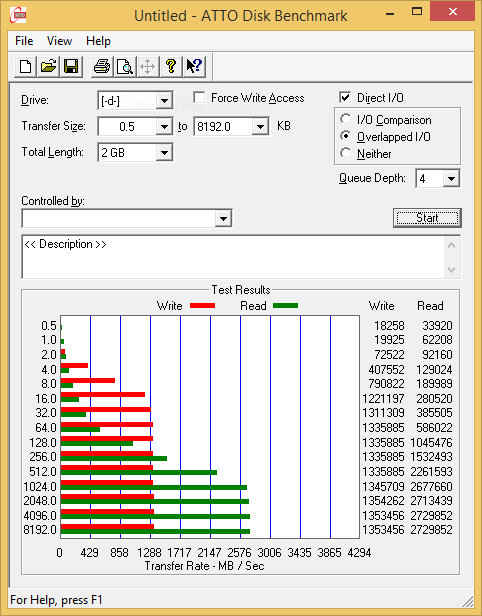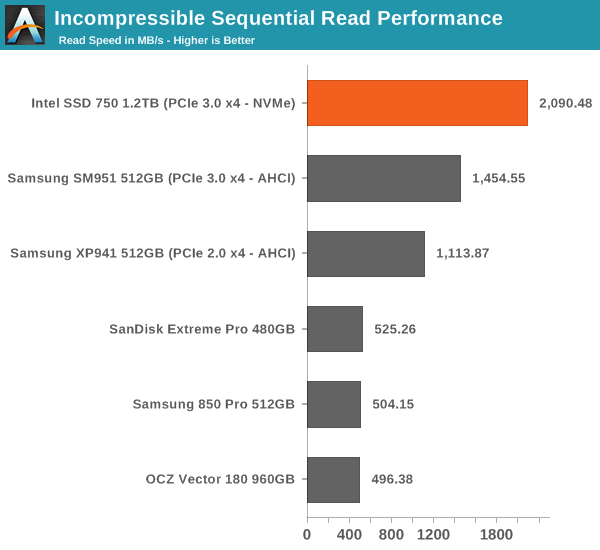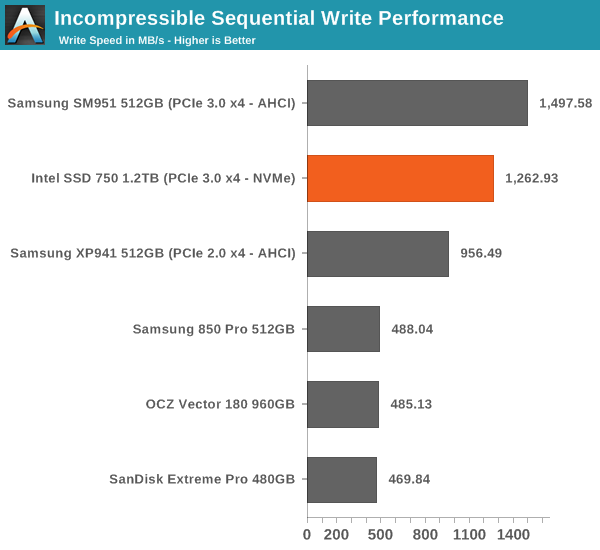Intel SSD 750 PCIe SSD Review: NVMe for the Client
by Kristian Vättö on April 2, 2015 12:00 PM ESTATTO - Transfer Size vs Performance
I'm keeping our ATTO test around because it's a tool that can easily be run by anyone and it provides a quick look into performance scaling across multiple transfer sizes. I'm providing the results in a slightly different format because the line graphs didn't work well with multiple drives and creating the graphs was rather painful since the results had to be manually inserted cell be cell as ATTO doesn't provide a 'save as CSV' functionality.
 |
|||||||||
AS-SSD Incompressible Sequential Performance
I'm also keeping AS-SSD around as it's freeware like ATTO and can be used by our readers to confirm that their drives operate properly. AS-SSD uses incompressible data for all of its transfers, so it's also a valuable tool when testing SandForce based drives that perform worse with incompressible data.


TRIM Validation
The move from Windows 7 to 8.1 introduced some problems with the methodology we have previously used to test TRIM functionality, so I had to come up with a new way to test. I tested a couple of different methods, but ultimately I decided to go with the easiest one that can actually be used by anyone. The software is simply called trimcheck and it was made by a developer that goes by the name CyberShadow in GitHub.
Trimcheck tests TRIM by creating a small, unique file and then deleting it. Next the program will check whether the data is still accessible by reading the raw LBA locations. If the data that is returned by the drive is all zeros, it has received the TRIM command and TRIM is functional.
And as expected TRIM appears to be working.











132 Comments
View All Comments
Per Hansson - Saturday, April 4, 2015 - link
It's most likely due to the poor performance of file transfers below 4KB with this drive.Shadowmaster625 - Thursday, April 2, 2015 - link
The funny thing is that the X25-M is STILL a great product. You can buy one on ebay and place it into a new build and it works just fine. And will continue to work just fine for many more years.eanazag - Thursday, April 2, 2015 - link
I have 4 X25-M 80 GB drives in RAID 0. The 750 is cheaper and faster than my setup. Price is based on what I paid several years ago for them.I would need a new motherboard and CPU to make this drive bootable. I do want.
Intel's PCIe lane bottleneck is pathetic. It seems to be a constant concern. X99 and Haswell-E is not the best answer to the problem. I am really skeptical about waiting for Skylake and the associated chipset. Broadwell for desktop hasn't even been released yet. Skylake for desktop will likely be next year at this rate.
DanNeely - Thursday, April 2, 2015 - link
Intel's never waivered from stating that SkyLake will launch on time and that all of the 14nm ramping delays will be absorbed by shortening broadwell's life. At this point I am wondering if desktop broadwell might end up being cut entirely in the mainstream market segment; with only the LGA2011 variant and possibly the LGA1150 celeron/pentium class chips that normally launch about a year after the rest of the product line on the desktop.r3loaded - Friday, April 3, 2015 - link
Skylake will bring 20 PCIe 3.0 lanes on the PCH, in addition to the PCIe 3.0 lanes coming off the CPU (Skylake-E CPUs will introduce PCIe 4.0) as well as support for up to three SATA Express/M.2 devices. Don't worry, Intel is well aware of the bandwidth bottleneck and they're addressing it.Hung_Low - Thursday, April 2, 2015 - link
So is thisi 750 the long rumoured P3500?Shadowmaster625 - Thursday, April 2, 2015 - link
I'm not satisfied with the explanations of why this product is slower than the SM951. By all rights it should be faster. Why would it still get a recommendation by anandtech?Kristian Vättö - Thursday, April 2, 2015 - link
It's only slower in the Heavy and Light traces, which focus more on peak performance rather than consistency. In The Destroyer trace the SSD 750 has significantly lower IO latency and that's what's critical for power users and professionals since it translates to more responsive system. The Heavy and Light traces don't really illustrate the workloads where the SSD 750 is aimed for, hence the SM951 is faster in those.BD2003 - Thursday, April 2, 2015 - link
Is it really measureably more responsive though? I guess I have a hard time believing that latencies measured in microseconds are going to bare out into any real world difference. Maybe it makes a difference on the single digit millisecond scale, but I'm talking real world here. Like is there any scenario where you'd be able to measure the *actual responsiveness*, meaning the time between clicking something and it actually responding to your command is measurably better? Even if it's just something minor like notepad opens in 50ms vs 100ms while you're compiling and backing up at the same time?Their target market is consumers so I feel like they've got to justify it on the basis of real world usage, not theory or benchmarks. From what I'm seeing here the SM951 looks like a better buy in every single way that matters.
SirPerro - Monday, April 6, 2015 - link
It's not about "clicking and responding". It's about different servers/databases handling hundreds of requests per second in a heavily multithreaded scenario.For UI interaction you probably cannot make the difference between this and the cheapest SSD on the market unless compared side by side.
As the review explains, this is targeted to a very specific niche. Whether people understand the scope of that niche or not is a different thing.